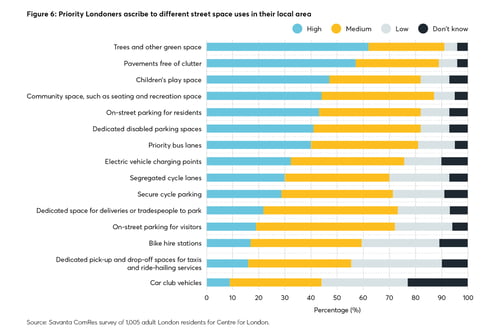Navigating the ever-changing on-street parking landscape

The global reduction of on-street parking in major towns and cities worldwide has started, with the aim to improve the quality of life for inhabitants. However, competition for the remaining spaces has accelerated the need for dynamic predictive services, without which, automakers will be unable to provide positive on-street parking experiences for drivers.
On-street parking is gradually being reduced by municipalities in order to improve the quality of life for those living in urban areas, which, according to the United Nations, accounts for over 55% of the population and continues to rise.
It is hoped that by converting on-street parking available within the most densely populated areas into bike and pedestrian lanes as well as pick-up and drop-off zones, drivers can be encouraged to use alternative forms of transportation for the final leg of their journey - reducing emissions, noise and congestion, and improving air quality and safety.
Global on-street parking inventory is decreasing
In 2020, Paris announced that it will remove 60,000 of its 140,000 on-street parking spaces to allow for more space for cyclists and pedestrians, and allow for an “ecological transformation of the city”, with the aim to improve daily life for Parisians. Since then, an additional 10,000 spaces and amenities for motorists have been removed, key thoroughfares have been made inaccessible to vehicles, and the previous 70,000 parking spaces have been replaced with ‘green spaces’, vegetable plots and playgrounds. Last year, Paris also announced a 50% increase in parking prices and the introduction of parking charges for motorcycles for the first time, with only electric motorbikes remaining exempt, aiming to encourage riders and drivers to switch to more environmentally friendly forms of transport in the city centre.
In London, where on-street parking takes up space equivalent to 10 Hyde Parks (or 14,164,000m2), the city has also implemented tighter parking regulations in densely populated areas, to encourage public transport and ‘active travel’. According to the Centre for London, residents want trees, green spaces, clutter-free pavements and more children’s play areas prioritised over on-street parking or EV charging points, however, neither car ownership, nor the proportion of trips made by public transport, walking or cycling, has changed significantly over the last three years, resulting in greater competition, for fewer spaces.

Recent COVID-19 restrictions also saw a reduction in on-street parking as municipalities promoted central businesses to expand their outside facilities. In 2021, Milan removed a tax related to the overall footprint to enable businesses to expand their outdoor facilities, allowing them to continue to trade under new social distancing restrictions, however, this resulted in the loss of around 3,000 parking spaces which were heavily utilised by visitors and residents.
Further challenges to on-street parking for ICE vehicles are plans to repurpose on-street parking spaces for EV vehicle charging only. A step to reducing emissions, but requiring the installation of a large volume of on-street chargers. Amsterdam is currently installing 1,100 new chargers as part of its aim to achieve ‘emission-free transport’ by 2030, however, critics suggest the scheme has significant financial challenges to provide the volume of chargers without substantial government grants, with on-street charging currently not proving commercially viable.
Dynamic on-street parking
As well as an overall reduction in the total number of spaces, drivers also now face greater restrictions on those that remain. Maximum stay times are significantly reduced and enforcement has been intensified, encouraging a much higher turn-over per space. Drivers who still wish to park curbside, now risk a much greater chance of receiving a fine if they fall foul of the many changing restrictions now in place.
Associated tariffs also continue to rise due to growing demand. In some cities such as New York, dynamic pricing is used, with prices increasing in line with times of peak demand and drivers charged based on the actual perceived value of the space rather than a static arbitrary amount. On-street is traditionally cheaper than off-street parking, however, dynamic pricing allows car park operators to incentivise drivers to use their facilities with prices now significantly lower than those on-street - looking to reduce situations where drivers circle around crowded streets looking for a space, causing additional pollution and congestion.
The more complex on-street parking landscape creates an even bigger need for accurate and granular on-street parking data, which is essential to support drivers by giving them the information required to make well-informed parking decisions as part of their overall journey.
Providing accurate and granular data
As the global leader in digital parking services, Parkopedia’s parking database now covers almost 1.5 million on-street locations worldwide, more than three times that of our nearest competitor, with 1 million locations added within the last 4 years alone. Frequent testing is also regularly carried out to maintain the accuracy and completeness of the data, as we work to continually close any gaps in coverage, such as areas with growing populations or rising parking pressures.
Over the last 4 years, our total completeness has also grown consistently to reach just under 99%. Data completeness refers to the comprehensiveness of the data with no gaps or missing information being present. Inaccurate or incomplete data renders the service unusable to the driver, potentially causing detrimental user experiences.
Parkopedia gathers dozens of static parking data attributes for every location, including the precise location of each on-street parking space. By leveraging parking payment transaction data and vehicle sensor data we are also able to provide the highest quality predictions available to drivers, with our dynamic data providing space occupancy information, as well as the “probability to find parking” by individual street segments and for off-street parking facilities.
Our predictions also continue to improve as cutting-edge machine learning and computer vision methods and partnerships help to solve difficult parking problems. By carefully managing the data collection process, Parkopedia has grown its dynamic data coverage availability by more than 600% over the last 4 years.
The foundation of what's to come
The removal of on-street parking in urban areas is a growing issue for automakers who want to provide their drivers with positive parking experiences and ‘peace of mind’ so they can effortlessly complete their journeys. In order to keep up with the dwindling supply of on-street spaces, evolving restrictions and strategic pricing models, automakers require accurate, complete and highly granular parking data that can be updated in real-time for the driver, and support highly automated seamless in-vehicle payments. This combination empowers drivers to make well-informed parking decisions, even when finishing journeys without ‘local knowledge’ at new destinations and also delivers upon the next generation in-car convenience services that are expected by drivers from today’s vehicles.
Eugene launched Parkopedia with the mission of improving the world by delivering innovative parking solutions and improving the struggles of everyday parking information for cities across the world
.png?width=1960&height=1103&name=parkopedia%20logo%20+%20arrive%20(1).png)